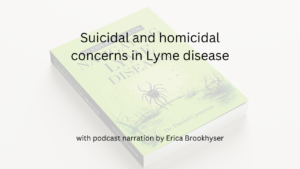Call for your appointment today 914-666-4665 | Mt. Kisco, New York

Hello, and welcome to another Inside Lyme Podcast. I am your host Dr. Daniel Cameron. In this podcast, I will be discussing the case of a 7-year-old child who was initially diagnosed with PANDAS and later, Lyme disease.
The article by Cross et al. entitled “Case Report: PANDAS and Persistent Lyme disease with Neuropsychiatric Symptoms: Treatment, Resolution and Recovery” was published in Frontiers in Psychiatry. [1]
The 7-year-old girl developed multiple physical and neuropsychiatric symptoms six months after travelling to a tick endemic region of the U.S. During this period, she was treated for 3 separate strep infections and was subsequently diagnosed with Pediatric Autoimmune Neuropsychiatric Disorders Associated with Streptococcal infections (PANDAS). PANDAS was considered based on classic symptoms and a history of strep, a positive ASO titer and a slightly elevated DNase B titer.
However, despite treatment, the patient’s symptoms continued to worsen. Additional testing revealed that she was also positive by CDC’s criteria for Lyme disease. The Lyme EIA and western blot IgM were positive (with 2 of 3 bands). The western blot IgG was positive for 3 of 10 bands at the IGeneX lab. Her B. henselae IgG was positive at Quest labs. Her IgG Mycoplasma and IgG Babesia duncani antibodies were positive at IGeneX.
Dr. Charles Ray Jones, co-author and treating physician, describes the patient’s broad range of symptoms.
Neuropsychiatric symptoms
On her first visit, “the patient presented with crying, anxiety, headache, joint pain, decreased cognitive functioning, fatigue, nighttime awakening and an extreme fear of sleeping alone.”
The patient’s symptoms were extensive, Jones explains, and included:
• Obsessions, compulsions
• ADHD-like behavior
• Decline in school work
• Separation anxiety
• Panic attacks
• Muscle and joint pain
• Mood lability
• Aggressive behavior
• Fatigue
• Headaches
• Difficulty sleeping
• Word selection problems
• Cognitive decline
• Irrational fears (would not sleep alone)
Functional decline
The young girl was considered a gifted child and excelled in academics. But cognitive symptoms emerged. She reportedly told her mother, “Mom, something happened to my brain.”
“The patient regressed from being a year ahead of her class in math, to being unable to add beyond the number 10. She began having trouble comprehending more difficult reading,” the authors explain.
“During a ride home with her mother, the patient asked, ‘Who are you? What’s your name again?’ And ‘I know you are mommy but what’s your name?’”
Lyme disease, PANDAS and PANS
PANDAS may be diagnosed when a strep infection triggers multiple neurologic and psychiatric symptoms. PANS or Pediatric Acute-Onset Neuropsychiatric Syndrome, on the other hand, may be triggered by other bacterial, viral or fungal infections. Researchers believe that Borrelia burgdorferi, the bacteria that causes Lyme disease can trigger PANS in some patients.
Lyme disease, PANS and PANDAS can present with similar symptoms. Dr. Bransfield, a psychiatrist who specializes in tick-borne diseases, describes a broad range of neuropsychiatric symptoms that he has seen in his Lyme disease patients. [2]
These include: behaviors associated with developmental disorders or autism spectrum disorder, schizoaffective disorders, bipolar disorder, depression, anxiety disorders (panic disorder, social anxiety disorder, generalized anxiety disorder, posttraumatic stress disorder, intrusive symptoms), eating disorder, decreased libido, sleep disorder, addiction, opioid addiction, cognitive impairments, dementia, seizure disorders, suicide, violence, anhedonia, depersonalization, dissociative episodes, derealization and other impairments.”
Treatment
According to the authors, the child was treated with multiple courses of oral and IV antibiotics including: intravenous ceftriaxone, Omnicef 300 mg BID, Zithromax 250 mg BID, 500 mg BID and Tindamax 250 mg QD (Saturdays and Sundays only), Bactrim and Mepron. Despite this, her symptoms continued and the Cunningham Panel™ of tests was ordered.
Cunningham Panel™ and IVIG
“The Cunningham Panel was ordered to assess the presence of antineuronal antibodies against specific neuronal receptors,” the authors write. “If the Cunningham Panel is positive or strongly positive, that would be an indication that one has an autoimmune problem that needs to be treated with IVIG, as well as antibiotics,” explains Jones.
READ MORE: Highlights from the case report
Panel results indicated the patient had elevated levels for 3 out of 4 autoantibodies: Dopamine D1 Receptor (DRD1), Dopamine D2L Receptor (DRD2L), and Tubulin (TUB).
“Based upon the patient’s Cunningham Panel tests results, the decision was made to prescribe IVIG,” the authors write.
“Over a span of 31 consecutive months of treatment with various antimicrobials and 3 courses of IVIG she experienced complete remission and remains symptom free at the time of this publication.”
Outcome
“Currently this patient appears to be fully recovered and has been discharged from the care of the pediatric Lyme disease specialist. She is asymptomatic and performing academically at the “top” of her class according to her mother,” the authors write.
According to Jones, “multiple concomitant infections may be involved and require treatment to effectively resolve symptoms. Improvement in neuropsychiatric symptoms does not typically occur unless all co-infections are addressed and resolved.”
This podcast addresses the following questions:
- What is Pediatric Autoimmune Neuropsychiatric Disorders Associated with Streptococcal infections (PANDAS)?
- What are the typical symptoms of PANDAS?
- What are the similarities between Lyme disease, PANS and PANDAS?
- Why was Lyme disease and other tick-borne illnesses considered?
- Why was the name Pediatric Acute-onset Neuropsychiatric Syndrome (PANS) introduced?
- What is the Cunningham Panel™ of tests and why was it ordered?
- What tests did the girl have that supported the diagnosis of a tick-borne illness?
- Can you discuss the range of symptoms this patient experienced?
- Can you discuss the girl’s treatment for PANS?
- Can you discuss the girl’s treatment for Lyme disease, Bartonella, and Babesia duncani?
- Thanks for listening to another Inside Lyme Podcast. You can read more about these cases in my show notes and on my website @DanielCameronMD.com. As always, it is your likes, comments, reviews, and shares that help spread the word about Lyme disease. Until next time on Inside Lyme.
Please remember that the advice given is general and not intended as specific advice as to any particular patient. If you require specific advice, then please seek that advice from an experienced professional.
Inside Lyme Podcast Series
This Inside Lyme case series will be discussed on my Facebook and made available on podcast and YouTube. As always, it is your likes, comments, and shares that help spread the word about this series and our work. If you can, please leave a review on iTunes or wherever else you get your podcasts.
References:
- Case Report: PANDAS and Persistent Lyme Disease With Neuropsychiatric Symptoms: Treatment, Resolution, and Recovery. Cross A., Bouboulis D., Shimasaki C., Jones C.R. Front. Psychiatry, 02 February 2021
- Bransfield RC. Suicide and Lyme and associated diseases. Neuropsychiatr Dis Treat. 2017;13:1575-1587. Published 2017 Jun 16. doi:10.2147/NDT.S136137.



